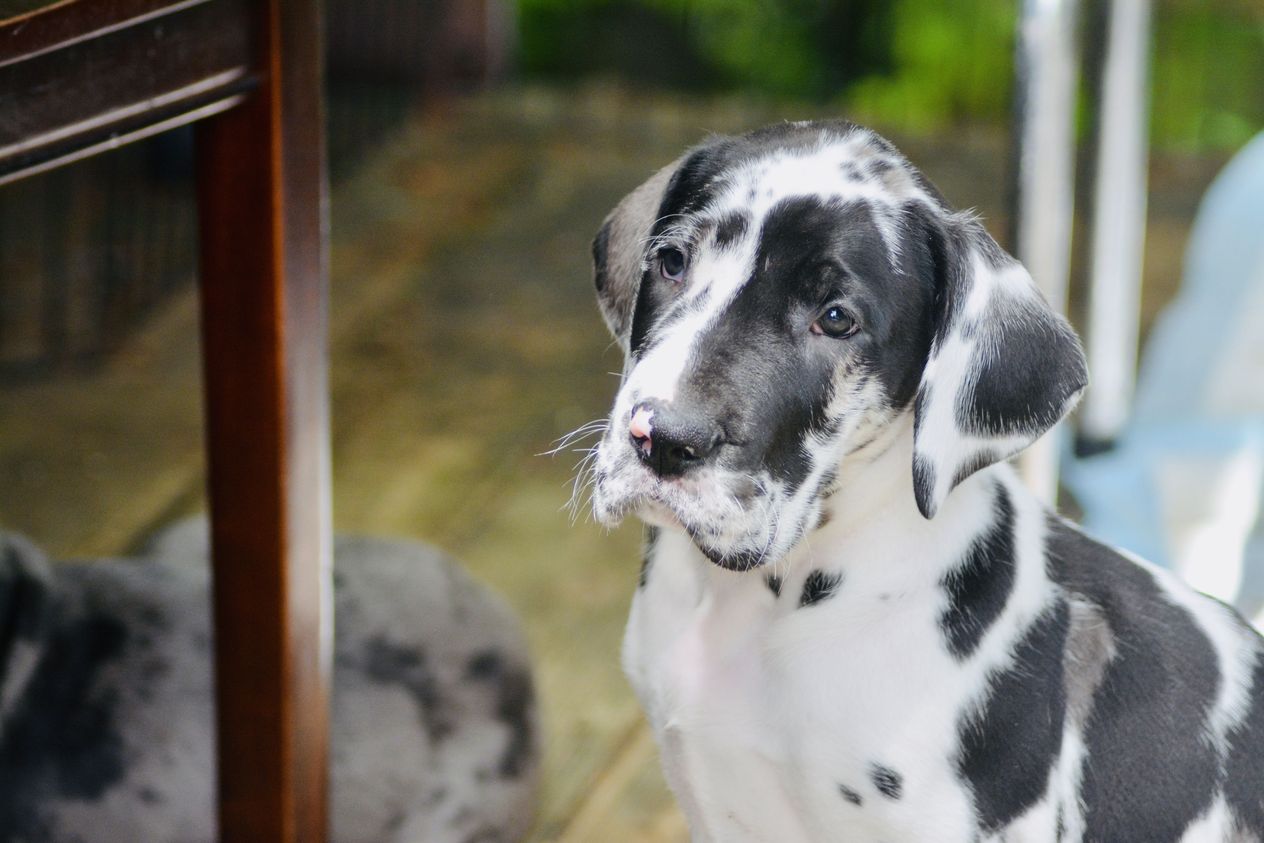Get to know
Great Danes

Veterinarian reviewed
Known as the Apollo of Dogs, the Great Dane does not disappoint.
Browse available puppies
Connect with reputable breeders to find the dog of your dreams
At a glance
Moderate Energy
Energy level
3/5
Minimal Maintenance
Grooming
1/5
Extra large, 110 to 180 pounds
Size
Friendly, willing to please, gentle
Temperament
7-10 years
Lifespan
Average Trainability
Training
3/5
Low Vocality
Barking
2/5
At a glance
Energy level
Moderate Energy
Grooming
Minimal Maintenance
Size
Extra large, 110 to 180 pounds
Temperament
Friendly, willing to please, gentle
Lifespan
7-10 years
Training
Average Trainability
Barking
Low Vocality
Why people love the breed
Dane owners love the breed’s combination of aristocracy and goofiness. They embrace the challenges of living with a giant dog.
Appearance
No other breed combines the look of great power and size with elegance as does the Great Dane.
Grooming
Grooming is easy. Just polish the coat occasionally. But do look out for drool.
European Great Danes
Breed temperament and characteristics
The description of gentle giant is overused, but totally appropriate for the Great Dane.
Exercise
Danes are big dogs and need to get outside to stretch their legs daily. But they aren't exercise fanatics.
TDT Great Danes
Training
Danes are willing to please, but don’t expect lightning quick responses. They do things at their pace, not yours.
Diet and nutrition
Big dogs need big nutrition. Fortunately many commercial meals meet that need.
Foto Danes
Health issues
Like most giant dogs, Great Danes have a comparatively short life span, and are more prone to some health problems and diseases.
Lifespan: 7 to 10 years.
Hip dysplasia
A complex condition involving both genetic and environmental factors that can cause varying degrees of pain and loss of function in the affected hip joint. No genetic test is available to date, therefore, the recommended screening test is x-rays. Definitive reports include OFA radiographs taken after 2 years of age or another recognized screening and grading program (e.g. PennHIP, BVA, SV, FCI) following the validated process and minimum age for that organization.
Dilated cardiomyopathy
A heart disease in which the heart muscle degenerates and becomes thinner, leading to a larger heart as the walls expand due to the pressure from the blood inside the heart. Cardiac evaluations are useful in screening dogs for congenital heart conditions that can be passed down to the puppies.
Gastric dilatation-volvulus
A life-threatening sudden twisting of the stomach. It is an extreme emergency that can be fatal if not treated immediately. Great Danes are predisposed due to their large, deep chest. A prophylactic gastropexy surgery can be performed to prevent torsion - most typically done at the time of spay or neuter.
Osteochondritis dissecans (OCD)
An abnormality of cartilage development causing an inflammatory condition when the disease's cartilage separates from the underlying bone. This painful condition can occur more frequently in large breed dogs who are not eating an appropriate large breed puppy diet.
Hypertrophic osteodystrophy (HOD)
This is a developmental, auto-inflammatory disease of the bones that can cause limping, pain, and joint swelling.
Other health issues
This includes panosteitis, megaesophagus, eyelid disorders including entropion (lid rolls inward) and ectropion (lid is everted), generalized demodicosis (demodectic mange) and splenic torsion.
History
He may be Great, but he’s not really a Dane.
About the author
Canine specialist, Caroline Coile, Ph.D., is the author of 34 dog books, including the top-selling Barron's Encyclopedia of Dog Breeds. She’s written thousands of magazine and web articles about dogs. She specializes in canine science, health, breeds and competitions. Caroline has won 20 national dog-writing awards, and was a 2015 Inductee into the Dog Writers Association of America Hall of Fame.
Veterinarian reviewed
Dr. Nate Ritter, DVM is the Veterinary Medical Director at Good Dog. He earned his Bachelor of Science in Biology from Lafayette College and his Doctor of Veterinary Medicine degree from Virginia-Maryland College of Veterinary Medicine. He is a member of the American Veterinary Medical Association, New York State Veterinary Medical Society, the Veterinary Medical Association of New York City, and the Society for Theriogenology. Additionally, he is a USDA-accredited veterinarian.
Breed Scorecard
Characteristics and temperament
Affectionate with family
4
Watchdog level
4
Playfulness
3
Adaptability
3
Social needs
4
Temperament
Friendly, willing to please, gentle
Intelligence
3
Good with other dogs
2
Good with cats or other pets
3
Friendly with strangers
4
Good as a service dog
3
Good for apartments
2
Barking level
2
Appearance
Height
28-30"
Size
Extra large, 110 to 180 pounds
Colors
Blue and white (non-standard), Black and white, Chocolate and white (non-standard), Chocolate brindle (non-standard), Mantle merle, Merlequin (non-standard), Chocolate (non-standard), Blue brindle (non-standard), White, Silver, Brindle, Fawn, Blue, Harlequin, Mantle, Merle, Black
Coat texture
Smooth, thick, glossy
Coat length
Short
Training
Trainability
3
Exercise
Exercise needs
3
Exercise time
About an hour a day
Mental exercise needs
2
Favorite activities
Grooming
Grooming needs
1
Brushing frequency
Monthly
Needs professional grooming?
No
Drooling level
4
Health issues
Hip dysplasia
Dilated cardiomyopathy
Gastric dilatation-volvulus
Osteochondritis dissecans (OCD)
Hypertrophic osteodystrophy (HOD)
Other health issues
Other
Bred for
Estate guardian; large game hunter
Country of origin
Germany
Popularity level
5
FAQs
On Good Dog, you can search for Great Dane puppies or dogs in rescues and shelters. Adopting a Great Dane from a shelter or rescue is generally less expensive than buying a puppy from a breeder with ethical practices. Across the United States, there are dedicated rescues that specialize in specific breeds and may even help transport a Great Dane dog to you from another part of the country. Although it can be more cost-effective, adopting the exact breed you're looking for is typically more difficult than working with a responsible breeder. Learn more about adopting a dog from a shelter or rescue.
The typical price for Great Dane puppies for sale may vary based on the breeder and individual puppy. On average, the price of Great Dane puppies from a breeder is $2,150.
Despite their size, Danes are definitely house dogs. They don’t do well in extreme heat or cold, nor are they happy when separated from their family. You just need a big house as they don’t fit well in small apartments.
When properly socialized, Danes are fairly friendly, and enjoy meeting new people. But they can also be protective.



